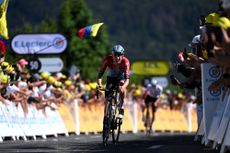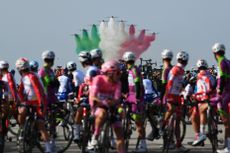Tour de France organisers 'not crazy enough' to put cobbles on stage one of 2025 race
Race's route designer says pavé will be back - just not in 2025


The Tour de France's organisers have revealed that they are not "crazy enough" to put cobbles in on stage one of the race in 2025, which is why they are absent from the route.
There was much speculation that the pavé of Paris-Roubaix would feature in the opening stages of the 2025 edition with the Grand Départ taking place in Lille, close to the sectors from the famous race. However, on Thursday, ASO, the Tour's organisers, revealed three routes which would not contain any pavé.
Cobbles normally accompany the Tour when it heads to Lille, as happened in 2022 and in 2014, but it will largely be a tarmac affair. The gravel stage in the 2024 Tour might have prevented the route directors from heading off-asphalt again so quickly, but also the fact that they would have to feature very early in the race.
The Tour's route designer, Thierry Gouvenou, told L’Équipe that pavé would be absent because of the decisions on start and finish towns, and also because cobbles would be put in on stage one.
“Given the choice we made of [start and finish] towns, we’d have had to have them on stage 1” - starting and finishing in Lille - “because the pavé is all in the south of the region,” Gouvenou told L’Équipe. “We didn’t feel crazy enough to put the riders in the cobbles on day 1.
“So we abandoned that idea. They [the pavé sectors] will be back, but not in 2025.”
Local rider and cobbled Classics specialist Adrien Petit, who rides for Intermarché-Circus-Wanty, supported the decision to keep cobbles away from the Grand Départ.
“It will be a tough opening weekend, the riders will be very nervous, and that’s why there’s no pavé,” he said. “It’s wise, we all know about how risky these opening stages are in any case.”
Stage one is a loop from Lille to Lille, and looks to be one for the sprinters. After that, there will be a punchy affair from Lauwin-Planque to Boulougne-sur-Mer, with the third stage heads from Valenciennes to Dunkerque, another hilly day.
Gouvenou was clear that the second stage, at 209km and with a jagged profile, would be a tricky day.
“It’s a long stage, and we deliberately included lots of changes of direction in the hope that crosswinds could have an effect,” he said.
“Saint-Étienne-au-Mont (900 metres at 11%) which has 300-400 metres at 15% is as hard as the Pike on stage 1 of the 2023 Tour.
“Then there’s Outreau, similar to the Cap-Blanc-Nez climb where Wout van Aert (Jumbo-Visma) attacked (on stage 4 in the 2022 Tour) and the final climb to Boulogne-sur-Mer.”
“All in all, it’s a much tougher stage than the one here in 2012”, when Peter Sagan won at Boulogne-sur-Mer, the route designer told La Voix du Nord.
“The final climb is less hard than the Porte Gayole, the last climb which was tackled that year. But what comes before makes for a much more difficult stage.
“With the new way of racing we have these days, I’m sure we’ll have all the top names right at the front of the pack. Anybody who’s badly positioned at the foot of these climbs risks losing a stack of time.”

Thank you for reading 20 articles this month* Join now for unlimited access
Enjoy your first month for just £1 / $1 / €1
*Read 5 free articles per month without a subscription

Join now for unlimited access
Try first month for just £1 / $1 / €1
Get The Leadout Newsletter
The latest race content, interviews, features, reviews and expert buying guides, direct to your inbox!

Adam is Cycling Weekly’s news editor – his greatest love is road racing but as long as he is cycling on tarmac, he's happy. Before joining Cycling Weekly he spent two years writing for Procycling, where he interviewed riders and wrote about racing, speaking to people as varied as Demi Vollering to Philippe Gilbert. Before cycling took over his professional life, he covered ecclesiastical matters at the world’s largest Anglican newspaper and politics at Business Insider. Don't ask how that is related to cycling.
-
 ‘For the first time, American gravel racing is the place to be’ — YouTube series 'Call of a Life Time' premiers January 26
‘For the first time, American gravel racing is the place to be’ — YouTube series 'Call of a Life Time' premiers January 26Now in its second season, Call of a Life Time chronicles all the action from the 2023 Life Time Grand Prix gravel racing series
By Kristin Jenny Published
-
 Cian Uijtdebroeks saga ends with Bora-Hansgrohe agreeing to contract termination
Cian Uijtdebroeks saga ends with Bora-Hansgrohe agreeing to contract terminationBelgian rider will be a Visma-Lease a Bike rider from 1 January
By Adam Becket Published
-
 Mark Cavendish: Altitude training is essential in order to stay at the top of modern cycling
Mark Cavendish: Altitude training is essential in order to stay at the top of modern cyclingBritish sprinter will start 2024 season at Tour Colombia in February and will also include two altitude camps in plan
By Tom Thewlis Published
-
 The Tour/Giro double could mean more conservative racing from Tadej Pogačar - does anyone want to see that?
The Tour/Giro double could mean more conservative racing from Tadej Pogačar - does anyone want to see that?The Slovenian is set to tackle both Grand Tours in 2024. Will he be able to emulate Marco Pantani?
By Adam Becket Published
-
 Mark Cavendish reveals details of first race in 2024
Mark Cavendish reveals details of first race in 2024Astana Qazaqstan rider will line up at the Tour Colombia after altitude camp in country
By Tom Thewlis Published
-
 A complete history of Ineos Grenadiers kits, from Adidas to Gobik, via Rapha
A complete history of Ineos Grenadiers kits, from Adidas to Gobik, via RaphaThe British team switch to Gobik in 2024 after two years with Bioracer
By Tom Thewlis Published
-
 Belgian rider slapped with 25 day ban for hitting rival in the head
Belgian rider slapped with 25 day ban for hitting rival in the head23-year-old Maxim Van Gils lashed out at Greek rider Giogios Bouglas as duo crossed finish line
By Tom Thewlis Published
-
 There should be no more flying in Grand Tours
There should be no more flying in Grand ToursIn the age of climate crisis, no race organiser should create an event that means air travel will be used
By Adam Becket Published
-
 Tour de France 2025 Grand Départ snubs Roubaix cobbles
Tour de France 2025 Grand Départ snubs Roubaix cobblesFirst three stages of 2025 Tour to take place in north of France, with headwinds, hills, and sprints, but no pavé
By Adam Becket Published
-
 Tom Pidcock and Laurens De Plus test 'challenging' Tour de France gravel ahead of 2024
Tom Pidcock and Laurens De Plus test 'challenging' Tour de France gravel ahead of 2024British rider recons stage around Troyes which will feature approximately 32 kilometres of unpaved roads
By Tom Thewlis Last updated









